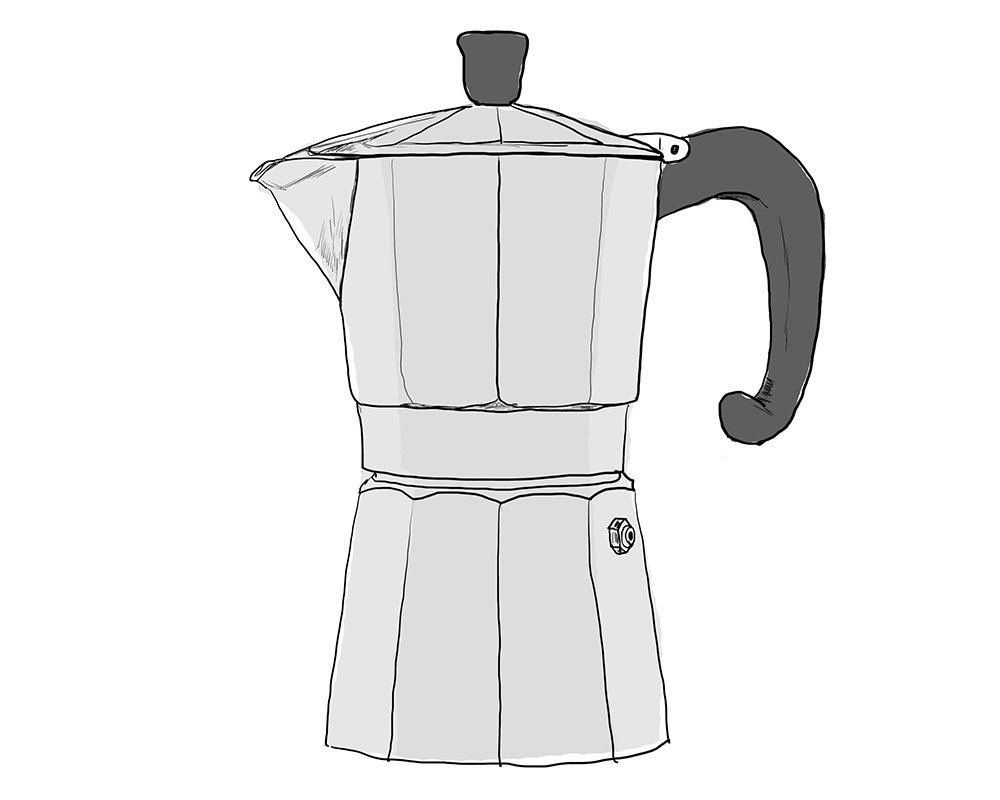5 Tips for Better Moka Pot Coffee
I regard the Moka pot as the median in the world of home coffee brewing. It is sandwiched between a home espresso machine and a pour over device, when evaluating it from a combination of cost, effort, time and coffee strength. I’ve come to enjoy using the Moka pot in my coffee brewing rotation.
I want to share my Moka pot coffee making process with you and then share 5 tips to help improve your Moka pot coffee experience and taste. These are tips I’ve picked up while applying my basic process.
Making a Moka pot:
Boil water (essential to getting a less bitter cup of coffee).
Grind beans (if applicable). Slightly coarser than espresso grind.
Pour the hot water into the bottom holder, until just below the pressure release valve.
Put ground coffee into the holder. Fill the basket but do not tamp i.e. press down and flatten.
Seal the unit (use a cloth or oven mitt because the bottom will be really hot.
Place it on medium heat
Remove from heat source when gurgling bubbling noises start.
Cool the bottom of the Moka pot under cold running water (if possible).
Pour.
Once you have the basic process down, here are my 5 tips that will help you understand and master the Moka pot:
Tip 1: Boil the water first
I recommended boiling the water prior to placing the moka pot on the stove. This is not the way a moka pot is traditionally made in Italy but I have tried both methods and would have to go with the modern coffee baristas like James Hoffman on this one. The resultant cup when using pre boiled water is a lot more pleasant and may be the reason why many people who have attempted using the Moka pot they were given as a gift, never tried again. The other associated tip when using pre-boiled water however, is to ensure you have a kitchen towel or dishcloth handy as the bottom reservoir is now very hot.
Tip 2: Use the correct coffee grounds
Freshly ground, good quality beans is the ideal but you can use ground coffee beans as well. Just ensure that you buy it as freshly roasted and ground as possible, store it in an airtight container and resist the urge to buy in bulk. Also look for the coffee method recommended for that grind. Try to buy a grind size suitable for the Moka pot.
If you have a grinder, then it is recommended that the coffee be ground slightly coarser than an espresso grind.
Tip 3: Don’t tamp the coffee grounds
A common mistake made when using this technique is to tamp and compress the grinds. People do this either out of habit, because it is what they see baristas doing or because they believe that it will increase the pressure with which the coffee is extracted.
Don’t do it!
Like with making a Moka pot using cold water, the resultant coffee will be unpleasant. Accept that you cannot make an espresso with a Moka Pot. The presence of crema will also not change my answer because the taste is the ultimate decider.
Tip 4: Stir the coffee
When the coffee is ready, it will be accompanied by a spluttering, gurgling sound. When you hear this, remove the Moka pot from the heat source and cool the bottom reservoir under running cold water or a damp cloth to stop the extraction process. I like giving the coffee in the top reservoir a few stirs before pouring it out. This is more necessary when you’re using a 2 or 3 cup pot. I’m pouring two cups generally and I would like both cups to taste the same.
Tip 5: Always clean the pot
Finally, there is this enduring rumour that you should never wash your Moka Pot. I am not sure which lazy husband came up with that excuse when confronted with the dirty dishes by his wife, but we need to end this bad behaviour. Clean the moka pot properly after each use.
Cleaning is so important because when the fresh grinds mix with the old grinds that were extracted a few days ago it will definitely affect the taste of your resultant cup, but not in a good way. Also, this is a pressurised device so keep an eye on the condition of the gasket and replace when it shows signs of cracking. If the unit is not sealed effectively, the duration and pressure of the extraction will be affected.
Those are my 5 tips!
I find the history of the Moka pot interesting.
The Moka pot was invented by Italian engineer Alfonso Bialetti and he got the inspiration (rumour has it), after watching his wife do the laundry using a precursor to modern day washing machines. It is named after the Yemini city of Mocha, which was known as the centre for buying and selling coffee up until the 19th century. I would highly recommend if you are interested in deep diving this topic, reading up on how the Moka pot essentially ended up ‘democratising’ the consumption of coffee and how it boosted its popularity across the globe. See ineedcoffee.com - the story of the bialetti moka express
Making a decent cup of coffee using the laundry machine inspired Moka pot and the technique above is obviously dependent on using fresh beans, good quality water etc. and as is often written, the perfect technique would always be undone by using poor quality beans or water.
So, if you happen upon a Moka Pot at their Air BnB or received one as a gift and want to make better coffee at home, try out these steps and leave a comment with any questions or tips for beginners. I would love to hear from you as well.

